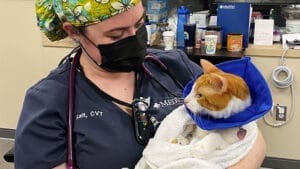
Feline Infectious Peritonitis (FIP): Understanding the Signs, Diagnosis, and New Treatment Options
FIP, a complex disease with few treatments and high mortality, now has new, effective therapies, improving the outlook for many cats.
Feline Infectious Peritonitis (FIP) is a complex disease that has historically had few effective treatments and high risk of death. Luckily for our feline friends the past few years have brought dramatic changes in how this condition is treated and the outlook for many of these cats has become much more positive. Veterinarians and cat parents alike are thrilled that this disease has become more treatable, that treatment is more easily accessible, and the lives of these sick cats can now be significantly improved.
What is Feline Infectious Peritonitis (FIP)?
The virus involved is a feline coronavirus. Though the coronavirus name is now familiar to many of us, this is a completely separate disease from the coronavirus we know as COVID-19, and it has been in existence much longer.
In most situations, when a cat is exposed to feline coronavirus, the cat does get an infection but shows minimal to no signs of illness. The cat recovers with no ill effects and develops some long-term immunity thanks to the normal function of the immune system. Unfortunately, immune responses can be excessive and even become detrimental, and this is what happens to transform a simple feline coronavirus infection into a case of FIP. Other factors differentiating feline coronavirus from FIP include the fact that feline coronavirus is primarily a gastrointestinal infection, but FIP becomes a systemic disease. Additionally, when the coronavirus virus expresses certain genes or mutates to be more virulent, it is more likely to lead to FIP.
Signs of Feline Infectious Peritonitis (FIP)
Signs of feline coronavirus are typically mild or even absent. In contrast, there are a lot of different signs associated with FIP including:
- Generalized low appetite, low activity, and weight loss
- Fluid (effusion) in the belly cavity or chest cavity
- Changes to major organs like the liver or kidneys (which can be noted on blood work or X-rays)
- Inflammation of the eye (uveitis)
- Bloodwork changes that can indicate a strong immune reaction
- Low red blood cell count
- Neurological signs
Your veterinarian may refer to ‘wet form’ or ‘dry form’ FIP. Wet form FIP is characterized by the presence of fluid in the belly or chest cavity, which can result in difficulty breathing. Dry form FIP is where little to no fluid accumulates, and the inflammation is confined to within organs like the kidneys, eyes, or nervous system. These descriptors can be helpful for veterinarians, but for pet parents, the difference is less important, as treatment is similar in both cases.

Diagnosis of Feline Infectious Peritonitis (FIP)
FIP has been a challenging disease to diagnose for veterinarians. One major reason is that the same virus causes two very different conditions, and since this virus is quite common, many cats can test positive without having FIP. Also, the signs of FIP can be vague, and many other conditions may need to be considered for a cat’s diagnosis. There are hints a veterinarian can get from bloodwork, but cats can have FIP with few bloodwork changes. Thus, other testing is often needed, which can include:
- Coronavirus testing
- FIP testing (PCR, immunohistochemistry)
- X-rays
- Abdominal ultrasound
- Fluid analysis (if wet form)
- Culture
- Biopsy or needle aspirate of an abnormal organ
- Special infectious disease testing for other conditions that can present similarly
There are some tests aimed at differentiating a cat testing positive for only feline coronavirus from a cat that is more likely to truly have FIP. The most helpful tests are PCR tests and monocyte immunohistochemistry. Often, we have an easier time making a correct diagnosis with wet-form FIP, as we can easily collect and test this fluid. Cats with dry-form FIP present a greater challenge, as blood is often our back-up fluid to test, but blood testing isn’t as helpful in FIP. This is where biopsies or needle aspirates may be needed to get the most useful samples. Sometimes, in a difficult case, we may consider starting treatment and watching to see if the patient improves.
Treatment for Feline Infectious Peritonitis (FIP)
One of the most remarkable developments in veterinary medicine is the transformation in the treatment of FIP over the past five years. Before 2020, FIP was considered a severe and almost universally fatal condition, with few effective treatments available.
During and immediately after the COVID-19 pandemic, coronavirus research efforts were accelerated ant the FIP treatment landscape rapidly evolved. We knew certain treatments worked, but they were often difficult to obtain. Even today, in the United States, the treatments that help these cats are not FDA-approved for use in cats; they are currently only labeled for human use. However, the FDA permits use in cats as long as the drug is compounded for an animal (not a person) and is made for a specific patient who needs it. As a result, we can now easily order effective treatments for cats with FIP, which was not possible just a few years ago.
The primary treatments for FIP are antiviral medications, which work to neutralize the virus. The drugs you might be prescribed can sound a bit technical, such as GS-441524, EIDD-1931 or remdesivir (a drug that did go to market for human use). The choice of drug may depend on availability in your area, the route of administration (oral or injection), or the cost. Cats with FIP may also require additional supportive care, including hospitalization, fluid therapy, anti-nausea treatments, or appetite stimulants. Cases involving the eyes may need special eye drops or consultation with a veterinary ophthalmologist. Cats with neurological signs may be more debilitated and may require more intensive supportive care.

Prognosis for Feline Infectious Peritonitis (FIP)
The prognosis for FIP has dramatically changed with these new treatments. Almost all FIP cases would have had little to no hope in the past, but now these cats can improve, return to normal, or even be cured. Since the availability of treatment is quite new, we are still learning the best treatment protocols, which cases require which drugs, and which cases are harder to treat. Cases with neurological involvement tend to be more difficult, and outcomes are more challenging to predict in cats who are really sick or debilitated when they are diagnosed. Cats with FIP now survive about 80-90% of the time. Getting through the first one to two days of treatment is the most critical, with almost all cats surviving after that critical period.
Risk of Feline Infectious Peritonitis (FIP) Spreading Among Household Cats
Cat owners may worry about the risks of a virus spreading within their house. Viruses are contagious, so it is logical to consider this. Yet, many of the issues caused in a cat with FIP are changes that develop within the cat’s body, and the initial exposure is just to a feline coronavirus. We don’t think FIP itself is contagious. However, if certain genes, strains, or mutations make a case of feline coronavirus more likely to become FIP, one could wonder if cats in the same household all have been exposed to a more ‘problematic’ strain of feline coronavirus and do have some (difficult to quantify) higher risk of FIP. In general, the number of cases of feline coronavirus that become FIP is small, and though you may worry, the risk is probably low. Feline coronavirus spreads via the fecal-oral route, so a thorough cleaning of bowls and litter boxes is probably the best advice for homes with a recent FIP diagnosis.
Visit our Pet Care Resources library for more pet health and safety information.
FAQs
What is Feline Infectious Peritonitis (FIP)?
What are the signs of Feline Infectious Peritonitis (FIP)?
How is Feline Infectious Peritonitis (FIP) treated?
Learn More
Veterinary internal medicine specialists are trained to treat your pet’s complicated internal systems, including GI tract, kidneys, central nervous system, and endocrine system.
Veterinary Internal MedicineContents
Learn More
Veterinary internal medicine specialists are trained to treat your pet’s complicated internal systems, including GI tract, kidneys, central nervous system, and endocrine system.
Veterinary Internal Medicine


